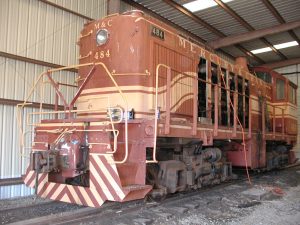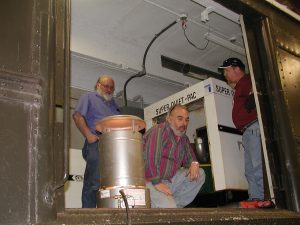The North Alabama Railroad Museum is currently engaged in an ambitious work program including the following projects:
- Repair / Rebuild of Prime Mover In Locomotive No. 484

History: Engine 484 was built by the American Locomotive Company (ALCO) in June 1949 for the Delaware Lackawanna & Western Railroad. After retiring from DL&W she was sold and eventually purchased by the Reynolds Metals Company in Sheffield, AL for use at their plant facilities there. In the late 70’s, Reynolds was gracious enough to donate 484 to the Museum. Engine 484 was a very tired and worn locomotive. While being removed from the property at Reynolds to take her place at her new home, she was literally pulled out of the dirt where she had been pushed out past the end of the track.
Restoration: Longtime North Alabama Railroad Museum volunteer Ed Martin and crew spent many hours getting 484 back into a condition where she would once again run. Once the museum moved to our current location at Chase around 1987 and for many years thereafter, engine 484 served faithfully as our only motive power. However, this little locomotive was still a tired and worn engine. She faced a failing turbo and finally, during our 2007 season, she was pulled from our active roster and placed in the reserve pool in case of emergency. Thankfully by that point, we had acquired two other locomotives that were capable of handling the duties assigned to them, engines 213 & 8652. Still, the museum had to call on 484 a few times when something was troubling one of the other engines, and she has never let us down. During a routine check in 2013, it was discovered that a tremendous amount of compression pressure was bypassing at least one of the pistons and was into the crankcase. NARM determined that the engine could no longer be operated safely in this condition. Not only was there the risk of a crankcase explosion, but oil was being forced out of the engine at an alarming rate. The decision was made to use the resources we have in house to troubleshoot and repair the prime mover.
Leak testing has determined that we have two cylinders that are provoking the pressure issues, with cylinder #5 being the prime offender. Once the repairs are made to cylinder #5, we will move forward and continue the repairs to cylinder #4, the other leaking cylinder. Additionally, we have also known for many years that the turbocharger is not performing nearly as well as it should. While we are working on the leaking cylinders, we intend to address the turbocharger issue also. Once all these repairs are completed in a few months, Engine 484 should emerge from the Mercury shops performing better than she has in decades. Hopefully, she will have traded the nasty thick black smoke she was producing for a clear stack and 1000 horsepower again!
- Installation of Generator into Baggage Car No. 139

Power Problems: Historically, passenger trains did very little lingering at the stations. Normally the time spent, even at a large station, was just a few minutes. This is very important for a number of reasons. First and most obvious, is the timetable to keep. A schedule had to be kept to keep each train arriving and departing the station at the announced time and to keep each train moving in coordination together. A lesser-known reason that, historically, passenger trains needed to keep moving was due to electrical power demands. The coach power systems for the lighting and air conditioning were 32 volts, 64 volts, or 110 volts direct current (VDC). The power supplied while stopped in any station was provided by a large bank of storage batteries beneath each coach. Just imagine those power requirements on a hot summer day-an enormous strain on each coach!
The power required by each coach would be around 15,000 to 20,000 watts. On a 32 VDC coach, a power drain in excess of 450 amperes would be required from the batteries while the train was stopped at a station. Even very large storage batteries cannot provide a supply that demanding for more than a few minutes. Fortunately, each coach was also supplied with an axle driven generator that was capable of producing about 25,000 watts once the train reached a speed of about 35 mph. In order to recharge the batteries and keep the passengers cool the train had to keep moving. In our small museum environment, this is neither practical nor possible. The most feasible and efficient way we can power our train is by engine driven alternating current (AC) generators. Our current configuration has a diesel engine driven AC generator beneath the coaches that is capable of producing the needed 15,000 to 20,000 watts per coach. While this solution does keep our train cool and the lights working, it is not the ideal situation due to the noise, vibration, and heat produced beneath the coaches.
NARM’s Solution: In order to give our passengers a more historically accurate and comfortable ride in our coaches, we will be moving away from the individual, coach-engine driven generators to a central, train-engine driven generator. Within the center of our Southern Baggage Car 139, we are installing a 150,000 watt self-contained, “quiet” diesel generator. Once completed, this will be capable of supplying all of our electrical requirements onboard the train, while still leaving the baggage car intact for people to relax in the open doors to enjoy the open feel that has always made this car so popular. Additionally, this generator gives us the capacity to add additional coaches in the future. We are hoping to add our Southern Sleeper Car, as well as an additional diner car. This install is taking place in such a way that the historical fabric of the baggage car is being kept intact and very little permanent changes being made within the car itself. We are hoping that with this renovation, our train should have a much more accurate representation of comfort, quiet, and smooth ride of days gone by.
- Restoration of the ALCo/GE/Ingersoll-Rand Boxcab Locomotive
The 1926 Boxcab Locomotive is of special interest to railroad historians. This locomotive and those of its type were the forerunners to the modern day diesel locomotives that eventually spelled the end of the steam era. This is a very rare locomotive that was built through a concerted effort with ALCo (American Locomotive Co.) building the body and related parts, General Electric furnishing the traction motors and electricals and Ingersoll-Rand providing the 300 horsepower prime mover. Our locomotive, originally No. 11 then and now, served breifly as a demonstrator unit and eventually was bought by Union Carbide in Niagra Falls. There it served for most of its life until it was transferred to the Union Carbide plant in Sheffield, Alabama. It was donated to our museum by Union Carbide on July 28, 1977. The prime mover was replaced in 1960 by a Caterpillar unit of the same horsepower rating. It is thought to be one of only a few boxcabs of this type left in the country and one of only 2 boxcabs left that had end doors. The restoration of the Boxcab outer body metal is largely complete. All the sections that had been severely altered have now been replaced to original configuration. All of the non-original windows have been replaced and good progress has also been made inside with a majority of the walls and ceiling being de-scaled, primed and painted. The National Railway Historical Society “Railway Heritage Grant” made much of this work possible. However, much work remains inside and out. On the outside the end steps that were added must be removed and the couplers and related mechanisms returned to original configuration. New doors will need to be built and numerous cosmetic appliances replaced. Inside, a complete control and brake stand will need to be replaced as well as many other items. And finally, the mechanical and electrical components will need a thorough rework before this locomotive can once again propel itself down the track.
- Miscellaneous Projects
At NARM, we always seem to have several projects going at any given time. Some of the projects in progress at present are:
- Exterior restoration of the Plevna Depot.
- Roof repair on several of the coaches is a constant need as leaks seem to develop out of no where.
- Track maintenance is always an ongoing project, but it is worth it in order to provide a good safe ride for our passengers.
- These are just a few of our ongoing projects. If you would like to become a member and help us complete some of these projects, or if you already are a member, you can see there is plenty of work to go around !